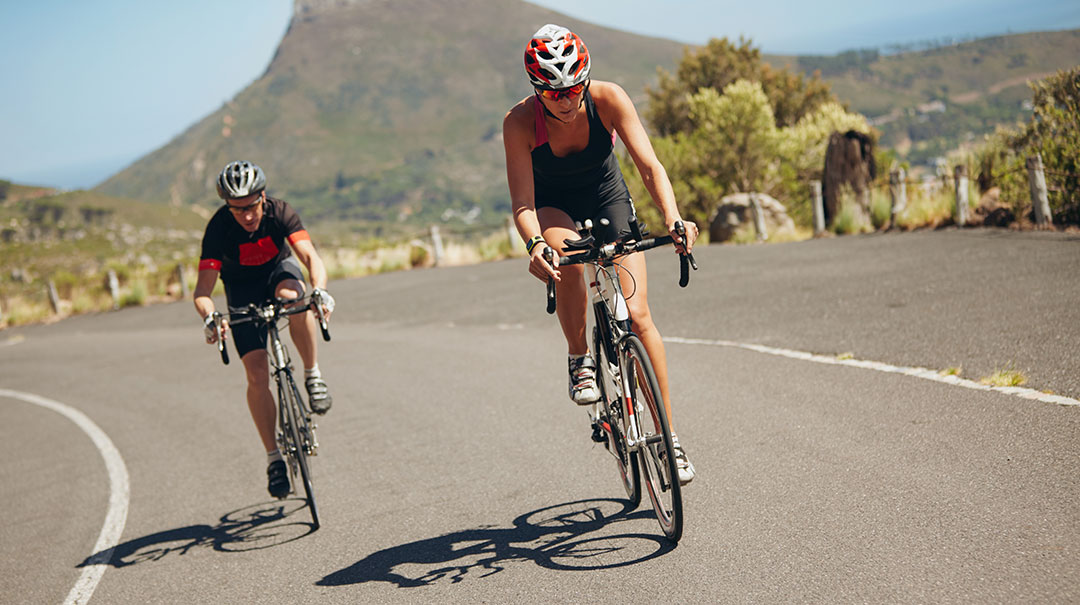Do you enjoy running, biking, swimming, or all three? Maybe you’re a runner looking for a challenge. Why not try a triathlon?
Triathlons are events that combine three different sports. Traditionally, triathlons include swimming, biking, and running—in that order. It’s an exciting event that pushes athletes out of their comfort zone and challenges the limits of their physical capability.
Ready to sign up for your first tri? Awesome! Keep reading for training tips for each of the three sports. Still on the fence? Maybe by the end of this, you’ll be ready to take on the challenge.
How Long is a Triathlon?
First things first, you have to pick a triathlon. You’ll want to consider which distance is best for you. There are four classic triathlon distances:
- Sprint: 16 miles—the distances vary, but in general, the swim portion is about 0.5 miles (750 m), the bike is 12.4 miles (20 km), and the run is 3.1 miles (5 km).
- Olympic: Approximately 32 miles—features a 0.93-mile (1.5 km) swim, a 24.8-mile (40 km) bike, and a 6.2-mile (10 km) run.
- Half Ironman: 70.3 miles—perfect for a race veteran looking for a challenge. The swim is 1.2 miles (3.8 km), the bike is 56 miles (90 km), and the run is 13.1 miles (21.09 km).
- Ironman: 140.6 miles—Ironman competitions take place all over the world. The annual world championship is held in Kona, Hawaii. This race consists of a 2.4-mile (3.8 km) swim, 112-mile (180 km) bike, and a 26.2-mile (42.2 km) run.
If you’re just starting out, you’ll probably want to begin with a sprint or Olympic triathlon before tackling the half or full Ironman. If you do decide to go for an Ironman, you’ll want to include a shorter distance triathlon as part of your training plan.
In the Baltimore and Washington, D.C., area, triathlon season is May through October. Athletes will usually spend the first season on a Sprint or Olympic race. If you’re up for the challenge, tackle a half Ironman in the second season and progress to a full Ironman. Training for an Ironman is a 12- to 24-month process.
How to Get the Most Out of Your Triathlon Training
When deciding which triathlon to compete in, consider what you want to get out of the race. Look for a challenge, but make sure you can commit the time to train. The longer the race, the more time you’ll need to spend training.
- Sprint: two to five hours training per week
- Olympic: three to seven hours training per week
- Half Ironman: eight to 12 hours training per week
- Ironman: 10 to 20 hours training per week
Your training plan should be realistic and manageable. Be sure to find a plan that fits your lifestyle. Aim to do at least two workouts per discipline each week – the distance and duration will vary depending on the race. You should start training with shorter distances, ramping up to longer distances and durations as the race approaches.
5 Tips to Be a More Confident Swimmer
Whether you can channel your inner Michael Phelps, or you feel like a fish out of water, don’t skip your swim workouts. The swim portion of the triathlon tends to be the most difficult and uncomfortable for many athletes—and it’s the first event in every triathlon!
You’ll want to start your race strong and confident. Your training is the key to feeling comfortable and confident during your swim.
Start simple. Begin by swimming for 15 minutes, taking breaks at the wall as needed. Gradually build up your swim time, aiming for 20 to 30 minutes continuously. The key to a successful swim is to be relaxed and confident in the water.
- Breathing: Find a breathing rhythm that allows you to comfortably inhale and exhale without stopping.
- Body Position and Balance: Practice your floating. Swimming with your head, hips, and legs on the surface will make your stroke more efficient. Practice staying afloat while you breathe without rotating your whole body to the side.
- Selecting Your Stroke: Swim freestyle as much as possible and use backstroke when you need a break. Breaststroke is not recommended for triathlons. The swim portion can be crowded, and the breaststroke increases the likelihood you’ll kick someone swimming next to or behind you.
- Practice in Open Water: Plan to swim in open water at least twice as part of your training. Swimming in open water is quite different from swimming in a pool, and swimming in open water causes anxiety for a lot of people. If you panic the first time you swim in open water, you’ll want that to be during training—not on race day. Practicing an open water swim allows you to channel that anxiety, move on, and not panic. In addition, never swim in open water by yourself.
- Take Lessons: If you’re unable to master the swim on your own, consider attending a clinic or taking lessons. There are swim instructors and courses designed specifically for triathletes.
During your training, mix up your strokes and technique. Use a kickboard and pull buoys to isolate your arms or legs, just be sure you’re not relying on these tools too much. When it comes to race day, you’ll likely still be a little anxious about the swim, but if you’ve done your training, you’ll be fine. Trust your training and try to relax. Next up is the bike. You’ll want to include two bike rides a week in your training plan. One of those rides should include a brick run.
What is Bricking and Why Should You Do It?
 Bricking is when you do a run right after your bike workout. You’ll want at least one of your bike workouts to include a brick run. The idea is to help train your body and brain to figure out the transition from biking to running. You’re using a lot of the same muscle groups, but the motion and pattern is completely different.
Bricking is when you do a run right after your bike workout. You’ll want at least one of your bike workouts to include a brick run. The idea is to help train your body and brain to figure out the transition from biking to running. You’re using a lot of the same muscle groups, but the motion and pattern is completely different.
When you first switch from biking to running, your heart rate will increase because running is more taxing on the cardiovascular system. By practicing this transition, you’re training your body to adjust your breathing rhythm and get to your normal run pace sooner.
Ideally, you’ll run for about 20 minutes after finishing your bike ride. You don’t need more than 20 minutes to experience the positive effects of bricking.
Benefits of the Walk and Run Option for Triathletes
The run is the last discipline of every triathlon after you’ve completed your swim and bike. As we discussed, the transition from the bike to the run will be difficult on your body and your brain. In addition to bricking as part of your training, you may consider the walk and run option on race day.
This strategy is used by many triathletes. Running is a high-intensity activity and our bodies can only maintain the increased heart rate and temperature for a limited amount of time. By incorporating a period of active recovery—walking—to your routine, the intensity is lowered, and you can sustain it longer.
You can go as slow as you want during the race. The cut off times are typically generous. For your first triathlon, keep your goal simply to finish. When you cross the finish line, you’ll be overwhelmed by a sense of accomplishment—and maybe even the itch to do another!
The key to success in each of the three sports is practice. Figure out your run routes, bike routes, and where you can swim. Make a training plan and stick to it. On race day, channel your anxiety and trust your training. You’ll be amazed at what you can accomplish.
Are you interested in training for an upcoming race or triathlon?
Schedule an appointment with Kate Ayoub,PT, and learn how to get fit for race day.
Learn More

